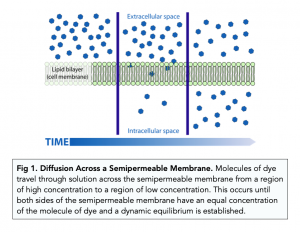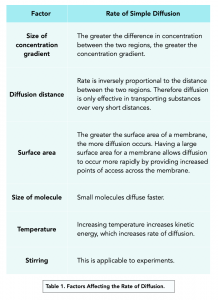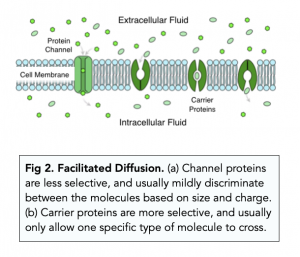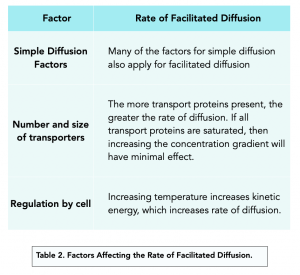Transport Across Membranes: Diffusion (A-level Biology)
Transport Across Membranes: Diffusion
Simple Diffusion
Simple Diffusion is the net movement of particles down a concentration gradient, from a high concentration to low concentration.
-
- Particles move down a concentration gradient. A concentration gradient is the difference in the concentrations of a substance between two regions, divided by the distance between the two regions. Diffusion follows a concentration gradient.
-
- Diffusion occurs until dynamic equilibrium. A particular substance will diffuse from a region of higher concentration to a region of lower concentration until the concentrations of the substance in both regions is equivalent. This is known as dynamic equilibrium.
-
- Diffusion is passive. Diffusion does not require energy. Particles continuously move around randomly, and particles tend to spread out until equilibrium is reached.

Factors Affecting Rate of Simple Diffusion

Membrane Thickness
- The membrane has to be very thin. The membrane has to be thin in order to provide the shortest path length, or distance for the substances to diffuse across.
- There is an upper limit on cell size. This size limit on the membrane places an upper limit on the size of the cell. Diffusion is a critical biological process, and to ensure that it readily occurs, cells have to be small enough to minimise the diffusion path length.
Simple Diffusion: Phospholipid Bilayer
- Non-polar molecules can simply diffuse across a membrane. Non-polar (lipid-based) molecules can simply pass through the phospholipid bilayer (as long as they are small). This is due to the hydrophobic and non-polar nature of the hydrophobic tails of the phospholipid bilayer.
- Very small molecules can also simply diffuse. Very small molecules and ions (e.g. CO2) are small enough to pass through the bilayer in between the phospholipid molecules.
Facilitated Diffusion
Facilitated diffusion refers to the transport of polar molecules and ions into and out of a cell. It involves the use of carrier and channel proteins.
- Polar molecules cannot pass by simple diffusion. Polar molecules cannot cross the hydrophobic barrier, so instead travel via facilitated diffusion (see below).
- Polar molecules instead diffuse by facilitated diffusion. Polar and hydrophilic molecules travel through carrier and channel proteins – they are ‘facilitated’ and assisted across.
- Transport proteins are adapted to their role. The channel and carrier structurally designed to interact with polar molecules:
-
- Many of these channel proteins have pores that are filled with water (attract hydrophilic molecules)
-
- Additionally, the proteins typically are polar in this pore region. Through this, they can readily interact with polar molecules and allow them to travel through these pores in order to either enter or exit a cell.

Factors Affecting Rate of Facilitated Diffusion

Diffusion is the movement of molecules from an area of high concentration to an area of low concentration, until the concentration of the molecules is equal throughout the system.
Diffusion is the movement of any type of molecule from an area of high concentration to an area of low concentration, whereas osmosis is specifically the diffusion of water molecules from an area of high concentration to an area of low concentration through a selectively permeable membrane.
Diffusion is an important mechanism for transport across membranes because it allows molecules to move from one side of the membrane to the other without the need for energy input. This is a passive process, which means it occurs spontaneously without the need for any extra effort.
A selectively permeable membrane is a type of biological membrane that allows some molecules to pass through, while others are blocked. The membrane has tiny pores that allow certain types of molecules to diffuse through, while others are too big to pass through and are blocked.
The concentration gradient is the difference in the concentration of a substance between two areas. The steeper the concentration gradient, the faster the rate of diffusion will be, as there is a greater difference in concentration for the molecules to diffuse towards.
Passive transport is a type of transport that does not require energy input from the cell. Diffusion is one type of passive transport, where molecules move from an area of high concentration to an area of low concentration until the concentration is equal throughout the system.
Facilitated diffusion is a type of passive transport where specific carrier proteins help molecules to diffuse across the membrane. Unlike regular diffusion, facilitated diffusion is specific to certain types of molecules and the rate of transport is influenced by the number of carrier proteins available.
Diffusion is a passive process, where molecules move from an area of high concentration to an area of low concentration without the need for energy input. Active transport, on the other hand, requires energy input from the cell and is used to move molecules against their concentration gradient, from an area of low concentration to an area of high concentration.
The size and charge of molecules affect their ability to diffuse across membranes because larger and charged molecules are unable to pass through the tiny pores in the selectively permeable membrane. Smaller and uncharged molecules are more likely to diffuse freely across the membrane.
The ability of molecules to diffuse across membranes is important for living organisms because it allows for the exchange of materials between the inside and outside of cells. This is necessary for processes such as respiration, where oxygen and carbon dioxide need to diffuse across membranes, and for the transport of nutrients and waste products.






Still got a question? Leave a comment
Leave a comment